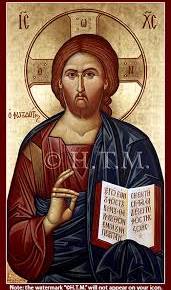

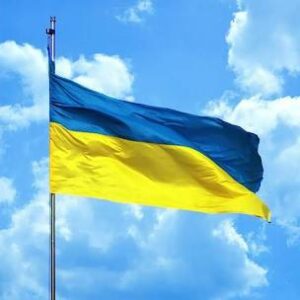
Saint Innocent, March 31

Don’t get me wrong – but I am tempted to dislike people like him. I knew some in high school and college: guys who did everything well. Bundles of energy and enthusiasm who were excellent scholars, good at sports, had good looks, attracted the girls, then went on to marry well, with good jobs and enviable families.
Saint Innocent was that kind. Certainly not in all the specifics – but in the life to which he was called, by the grace of God he also did all things exceptionally well. I have a feeling if we lost him, he’d come after us. That’s why he’s called Saint Innocent.
I don’t really dislike Saint Innocent. It’s just that he makes me feel inferior. Which I am.
His is a truly remarkable story.
Saint Innocent’s early life
Born on August 26, 1797, in the town of Angarsk in the Irkutsk Diocese of Siberian Russia, to Evsey Popov and his wife. His Baptismal name was Иван/Ivan (John).
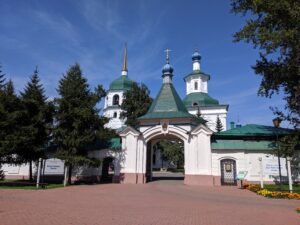
Ivan’s father died when he was six or seven, after which he lived with his uncle who was a parish deacon. In 1807, when he was ten, Ivan entered the Irkutsk Theological Seminary, where the rector renamed him Veniaminov * in honor of their recently deceased Bishop Veniamin.
He did so well at the seminary that the authorities had him in “the bishop’s track”, as they call it. As you know, Orthodox bishops cannot be married. However, Veniaminov had something else in mind. He and Catherine, the pretty daughter of a local priest, fell in love, and without telling anyone they married. And that was the end of “the bishop’s track”!
Ivan was ordained deacon and then, in 1821, ordained priest and pastor of a church in Irkutsk. Giving up the name Veniaminov (and who can blame him?) he went back to using his Baptismal name. He was “Father Ivan / Father John”.
Only two years later, in 1823, Bishop Michael of Irkutsk received instructions to send a priest to the island of Unalaska in the Aleutian Islands of Alaska. Father Ivan volunteered to go. I do hope he talked this over with Catherine this first. Besides, they had a newly born son (named Innocent).
On May 7, 1823, Father Ivan departed from Irkutsk. Accompanied by his wife and their infant son, his aging mother, and his brother Stefan, they headed east.
Greater Russia, now known as the Russian Federation.. Unalaska Island was 3445 miles * away “ as the crow flies”, but in their day the route was much longer.
- 5544 kilometers to you who are outside the USA, to whom I want to try to be sensitive, since some Americans these days are not. I do not understand why “Making America Great” should require putting everybody else down.
- The Russian Federation is vast: over eight hours to fly across it, over eight days by train.
I haven’t found any information about their route. My guess is that they traveled along the more or less settled southern border of Siberia to the city of Vladivostok. (That would be 2380 miles, 3834 kilometers.) And then by ship another 2800 miles, 4530 kilometers) across the stormy North Pacific to Unalaska, which is an island about midway through Alaska’s Aleutian chain. Though it’s possible they made their way somehow to the far eastern tip of Siberia, then across the relatively narrow Bering Straits.
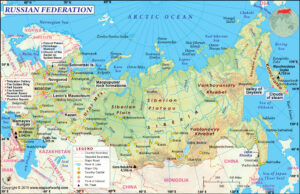
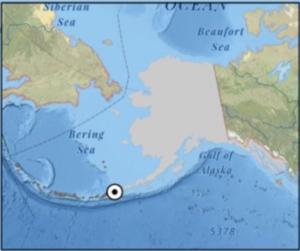
Siberia
Let me tell you a little about this huge land, which is about half again as large as the continental United States.
Siberia lies east of the Ural Mountains. It is not Russia proper. but rather had become part of the Russian Empire, “Greater Russia” which is still in the news today. Originally Siberia consisted of many independent tribes and nations. It was to Russia approximately as the West was to the USA. They had their own version of “Manifest Destiny”, only headed east till they met American “Manifest Destiny” headed west. The Russian conquest of Siberia began in 1581. Urkutsk was settled by the Russians in 1652. It was not till 1749 that Chukotka in the far east was settled, after which they moved on into Alaska. Unalaska was first settled in 1759.
Just as Roman Catholic and Anglican missionaries followed the European colonization of the Americas, Africa, India, Australia and New Zealand, in the same way Orthodox missionaries followed the Russian colonization of Siberia and Alaska.
I just wanted to give Saint Innocent’s journey some historical context.
To Alaska
Let’s look at what their journey entailed. The airplane wouldn’t be invented for another ninety years. The automobile and the Trans-Siberian Railway had not yet been imagined. There were only the most primitive roads and paths for their horse-drawn wagons, or sledges in the winter. Surely they must have gone by boat when they could, but Siberia’s rivers mostly run south to north, towards the Arctic Ocean, so that would have been little help.
And the weather: The trip took over a year, which meant they spent winter on the road. The average winter temperature in southern Siberia is at best 5 degrees above zero F /-5 C. How ever did they manage this?
They arrived at Unalaska on July 29, 1824.
Alaska: Saint Innocent begins his work.
Father Ivan and his family moved into an earthen hut. Again, after the settled comfort they had known inIrkutsk, I wonder how Catherine reacted to this. But perhaps she had the same adventurous missionary spirit as he.
At first his work was chiefly on Unalaska and among the nearby Fox and Pribilof islands He traveled by canoe among the islands, facing the frequently stormy waters of the Aleutians.
There were many peoples and tribes in Alaska, each with its own language or dialect. Father John’ did not teach them Russian. He did not try to turn the Alaskan natives into people who dressed and acted and talked like Russians. He came to make them Orthodox Alaskans.
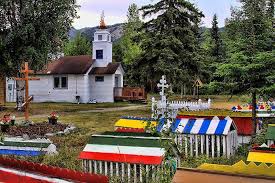 Traditional native Alaskan “spirit houses” where offerings were once made for the dead are now places where Alaskan Orthodox go to pray for their departed loved ones. The following program on the subject is from National Public Radio: https://www.npr.org/2012/06/25/155431017/in-alaskan-cemetery-native-and-orthodox-rites-mix
Traditional native Alaskan “spirit houses” where offerings were once made for the dead are now places where Alaskan Orthodox go to pray for their departed loved ones. The following program on the subject is from National Public Radio: https://www.npr.org/2012/06/25/155431017/in-alaskan-cemetery-native-and-orthodox-rites-mix
He began by learning dialects of the local people, spending years at a time with each. He learned the Tlingit language of the Kolosh people in the far remote settlements of what would become the Kamchatka diocese, and the Koryak, Chukchei, Tungus in the Yakutsk regions, and the Amur and the Usuriisk region. He invented an alphabet and system of grammar for the Aleut language.
For the next 28 years he traveled through the islands, He mastered six of the dialects. He devised an alphabet using Cyrillic letters for the most widely used dialect, the Unangan dialect of Aleut. In 1828, he translated portions of the Bible and other church material into that dialect. In 1829, he journeyed to the Bering Sea coast of the Alaskan mainland and preached to the people there. In 1833, he wrote, in that language, a book still considered a classic guide to Orthodox missionary activity: Indication of the Way to the Kingdom of Heaven.
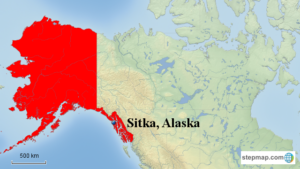 After spending ten years in the Aleutians, he moved his headquarters south to Sitka (then called Novo Arkangelski) in the southeast of Alaska, along the famous “Inside Passage” – another 800 miles (1287 km) away. There he began to preach to and baptize the Kolosh Indians and wrote the first scholarly accounts of the peoples of Alaska. *
After spending ten years in the Aleutians, he moved his headquarters south to Sitka (then called Novo Arkangelski) in the southeast of Alaska, along the famous “Inside Passage” – another 800 miles (1287 km) away. There he began to preach to and baptize the Kolosh Indians and wrote the first scholarly accounts of the peoples of Alaska. *
- I hope I’ve kept all these peoples and places straight. (I know almost nothing about early Alaska.) If not, will someone please correct me.
He loved to win people to the Faith and was greatly skilled at it. He said, ‘Whoever abounds in faith and love, can have mouth and wisdom, and the heart cannot resist their serving it.’”
So when any new opportunity arose, he took it. So in 1836, Father John traveled another 1400 miles (2250 km) to the south. Did you know that northwestern California was then considered Russian territory? * He landed at Fort Ross, not far north of present-day San Francisco, where he conducted a census, taught and baptized and performed marriages for the Russian population and well as local natives.
- The Spanish missionaries from the south didn’t see it that way.
I have been giving you all this information about journeys and miles and kilometers just to give you a sense of how much this holy man gave of himself.
Note that all this time, Saint Innocent was not yet a bishop, but only “Father Ivan”.
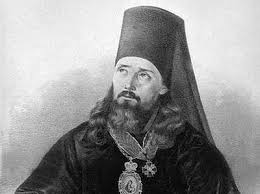
In the year 1840 he was back in Russia again, visiting Saint Petersburg, Moscow and Kyiv/Kiev seeking support for his Alaska mission. There came the news that his wife had died. In his grief he requested permission to return to his home town where he had first known her. The authorities wisely convinced him that he was needed in Alaska, and that he could serve Alaska better as a bishop. He finally agreed, took monastic vows and returned to Alaska as Bishop of the new Diocese of Kamchatka, “which extended from the Kamchatka Peninsula to the Alaska Peninsula, including the Kuril and the Aleutian islands and the region of Yakutsk.”
On April 21, 1850 he was elevated to become Archbishop. He built churches and schools, and ultimately established four separate dioceses. It is estimated that he baptized about ten thousand people.
Surely to his amazement, in 1868 he was elected to the position of Metropolitan of Moscow. We can only imagine what heartache he must have felt to leave his beloved people of Alaska after 44 years with them, but he accepted his new calling as the will of God. Now he traveled back across Siberia again for the last time.
Metropolitan Innocent threw himself into his new work, just as enthusiastically as he had when he first went to Alaska. He corrected errors in liturgical books. He established an Orthodox Missionary Society which continued its work till the Russian Revolution, and the Protection Monastery in Moscow was reorganized to be a center for missionary work. In 1870 he established the Japanese Orthodox Mission, headed by Archimandrite Nicholas Kasatkin, later to be known as Saint Nicholas of Japan.
Before he died, showing his typical talent for organizing things, Metropolitan Innocent directed the theme for the sermon to be preached at his funeral: “The steps of a man are rightly ordered by the Lord” (Psalm 36/37:23).
Saint. Innocent, Enlighener of North America and Metropolitan of Moscow, fell asleep in the Lord on March 31, 1879, He was buried at the Holy Spirit Church at the Trinity-St. Sergius Lavra near Moscow.
Saint Innocent of Alaska was glorified (canonized) by the Russian Orthodox Church on October 6, 1977. I cannot imagine why it took them so long to do it.
The Rest of the Story
At Home in Russia
After the 1917 Revolution, the Bolshevik “Communists” destroyed churches and monasteries, bodies and relics of saints. Someone unknown to us hid the body of Saint Innocent. His relics were discovered in 1994, during excavations on the grounds near the Holy Ghost Church at the Troitse-Sergiyeva (Holy Trinity-Saint Sergious) Lavra, His relics are now venerated there at Assumption Cathedral, and also by the faithful both in Russia and America.

Saint Innocent was one of those people whose God-given boundless energy and goodness and abilities and accomplishments and love just overwhelm the rest of us.
I’m sure people were quietly calling him Saint Innocent, long before 1977. What an extraordinarily remarkable man.
Addendum: Back in Alaska
Warning: Much of what follows will be distressing.
1
Protestant Missionaries in Alaska
The following is a portion of a startling paper “Uprooting Where Others Sowed? Presbyterian and Moravian Missionaries in Russian Orthodox Alaska” by George Faithful, Seton Hall University, 2013.
In contrast to their Orthodox counterparts, Protestant missionaries attempted to change Native culture as much as possible, molding indigenous Alaskans in their own image after the region passed into United States control in 1867. Due to both their prominence in missionary work in Alaska and to their previous history in missions to indigenous peoples, this presentation will limit its discussion of Protestant missionaries to Presbyterians and Moravians. There were certainly others: Baptists, Episcopalians, and Methodists, to name a few. Protestant mission agencies collaborated with one another to minimize geographical overlap, so as to collectively
encompass the whole of Alaska, including those areas where Orthodoxy was strongest.
Presbyterians and Moravians’ dismissive attitudes toward Native culture contrasted with both their Orthodox contemporaries and with their forebears in their own respective traditions. Missionaries from both denominations began to reach out to tribes that ranged from solidly to nominally Russian Orthodox, some of whom remain in the fold today. Catholic missionaries, by contrast, focused their efforts on the unreached peoples in Alaska’s vast inland regions.
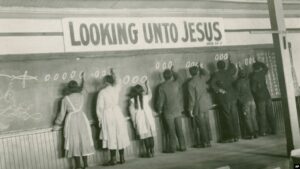
Program from Voice of America: https://www.voanews.com/a/americas_us-churches-reckon-traumatic-legacy-native-schools/6208608.html
Presbyterian missionary Sheldon Jackson began work in Alaska in 1877. In 1885, after he personally beseeched congress for educational aid for the new territory, the federal government appointed him Alaska’s General Agent of Education, a role in which he served until 1906. In that capacity, he recruited missionaries from a wide variety of Protestant denominations to run schools and orphanages, all federally funded. Among them were Moravians, who established Bethel, which quickly became southwest Alaska’s largest settlement. The first priority was to
teach the indigenous peoples how to be good Christians.
In the process, they needed to learn how to speak English. With funding from the federal government and backed by a staunch lobbyist in Washington, who was himself a former missionary, missionaries established schools, especially boarding schools, for Native children, some but not all of whom were orphans. Teachers did not merely fail to teach Native culture; that would be understandable, given their ignorance of it. They punished the use of Native language by students, thereby instilling in many of them an attitude of shame and ambivalence toward their own heritage. The students of these boarding schools often internalized and perpetuated this approach, forbidding the speaking of their tribe’s language in their own children, so as to spare them any possible reprisals.,,,
2
https://www.pbs.org/newshour/show/biden-issues-long-overdue-apology-for-federal-indigenous-boarding-schools
3
ANCHORAGE, Alaska (AP) October 28,2024 — Shells fell on the Alaska Native village as winter approached, and then sailors landed and burned what was left of homes, food caches and canoes. Conditions grew so dire in the following months that elders sacrificed their own lives to spare food for surviving children.
It was Oct. 26, 1882, in Angoon, a Tlingit village of about 420 people in the southeastern Aalaska panhandle. Now, 142 years later, the perpetrator of the bombardment — the U.S. Navy — has apologized.
4
From an article “Wartime Internment of Native Alaskans” (National Waorld War II Museum, June 20, 2022
“In October 1943, while Americans prepared for another year of rationing and sacrifices for the war effort, Dr. Berneta Block, a representative from the United States Department of Health, was dispatched to Alaska to investigate the living conditions of the 800 indigenous Unangan (Aleuts) from the Aleutian Islands. The Unangan had been evacuated from their homes following the Japanese bombing of Dutch Harbor and invasion of the Attu and Kiska Islands in June 1942. Censorship of events in Alaska during the Aleutian Islands campaign prevented few details of their removal and subsequent internment overseen by the Department of the Interior, the Office of Indian Affairs, and the Fish and Wildlife Service, and certainly no Americans were privy to the despair that Block encountered during her visit.
“Block arrived expecting to assess an outbreak of measles among the Unangan from the Pribilof Islands of St. George and St. Peter held at a former fish cannery at Funter Bay on Admiralty Island but, instead, found the circumstances the Unangan were forced into by the US government worse than she imagined. Once she entered the first bunkhouse where multiple families shared only two or three rooms quartered off with grimy bed sheets for makeshift dividing walls, her horror overwhelmed her. “As we entered the first bunkhouse, the odor of human excreta and waste was so pungent that I could hardly make the grade,” she noted. She and the other investigators laid their eyes upon mothers and children who shared single bunkbeds, huddled together in the damp cold and darkness, and found other children “naked and covered with excreta.” No proper sewage system existed for the inhabitants and the only water supply from a nearby creek was “discolored” and polluted. As another official noted, no living being should be forced to inhabit these conditions.”
5
Today approximately five percent of Alaskans remain Orthodox. Of course, there have now been many “immigrants” from the lower 48, few of whom were Orthodox.
Next Week: Saint Theodora the Righteous of Thessaloniki
Week after Next: Unless I’m counting wrong, it will be time to begin my annual twice-daily Holy Week Series beginning with Lazarus Saturday.
___________________________
Sources used in preparing this Post:
Orthodox Church of America
orthodoxtacoma.com
Orthodox Wiki
Wikipedia
saintinnocent.org
scholardominican.edu
National Public Radio
Voice of America